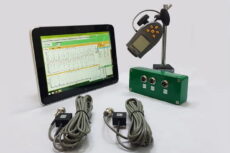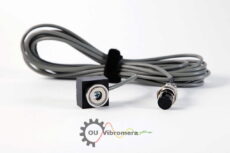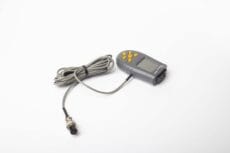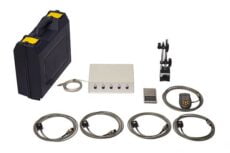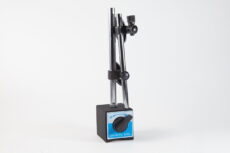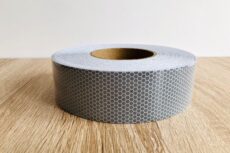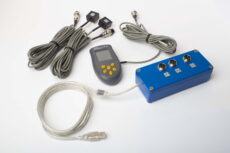4. Measurement Systems for Balancing Machines
Most amateur manufacturers of balancing machines, who contact LLC “Kinematics”, plan to use the “Balanset” series measurement systems manufactured by our company in their designs. However, there are also some customers who plan to manufacture such measuring systems independently. Therefore, it makes sense to discuss the construction of a measuring system for a balancing machine in more detail. The main requirement for these systems is the need to provide high-precision measurements of the amplitude and phase of the rotational component of the vibrational signal, which appears at the rotation frequency of the balanced rotor. This goal is usually achieved by using a combination of technical solutions, including:
4.1. Selection of Vibration Sensors
In the measurement systems of balancing machines, various types of vibration sensors (transducers) can be used, including:
4.1.1. Vibration Acceleration Sensors
Among vibration acceleration sensors, piezo and capacitive (chip) accelerometers are the most widely used, which can be effectively used in Soft Bearing type balancing machines. In practice, it is generally permissible to use vibration acceleration sensors with conversion coefficients (Kpr) ranging from 10 to 30 mV/(m/s²). In balancing machines that require particularly high balancing accuracy, it is advisable to use accelerometers with Kpr reaching levels of 100 mV/(m/s²) and above. As an example of piezo accelerometers that can be used as vibration sensors for balancing machines, Figure 4.1 shows the DN3M1 and DN3M1V6 piezo accelerometers manufactured by LLC “Izmeritel”.
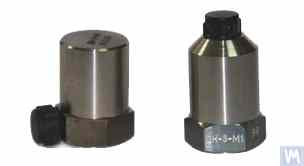
Figure 4.1. Piezo Accelerometers DN 3M1 and DN 3M1V6
To connect such sensors to vibration measuring instruments and systems, it is necessary to use external or built-in charge amplifiers.
Figure 4.2. Capacitive Accelerometers AD1 Manufactured by LLC “Kinematics”
It should be noted that these sensors, which include widely used market boards of capacitive accelerometers ADXL 345 (see Figure 4.3), have several significant advantages over piezo accelerometers. Specifically, they are 4 to 8 times cheaper with similar technical characteristics. Moreover, they do not require the use of costly and finicky charge amplifiers needed for piezo accelerometers.
In cases where both types of accelerometers are used in the measurement systems of balancing machines, hardware integration (or double integration) of the sensor signals is usually performed.
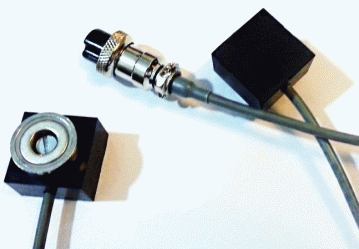
Figure 4.2. Capacitive Accelerometers AD 1, assembled.
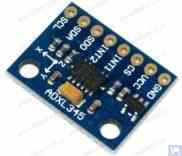
Figure 4.3. Capacitive accelerometer board ADXL 345.
In this case, the initial sensor signal, proportional to vibrational acceleration, is accordingly transformed into a signal proportional to vibrational velocity or displacement. The procedure of double integration of the vibration signal is particularly relevant when using accelerometers as part of the measuring systems for low-speed balancing machines, where the lower rotor rotation frequency range during balancing can reach 120 rpm and below. When using capacitive accelerometers in the measuring systems of balancing machines, it should be considered that after integration, their signals may contain low-frequency interference, manifesting in the frequency range from 0.5 to 3 Hz. This may limit the lower frequency range of balancing on machines intended to use these sensors.
4.1.2. Vibration Velocity Sensors 4.1.2.1. Inductive Vibration Velocity Sensors. These sensors include an inductive coil and a magnetic core. When the coil vibrates relative to a stationary core (or the core relative to a stationary coil), an EMF is induced in the coil, the voltage of which is directly proportional to the vibration velocity of the movable element of the sensor. The conversion coefficients (Кпр) of inductive sensors are usually quite high, reaching several tens or even hundreds of mV/mm/sec. In particular, the conversion coefficient of the Schenck model T77 sensor is 80 mV/mm/sec, and for the IRD Mechanalysis model 544M sensor, it is 40 mV/mm/sec. In some cases (for example, in Schenck balancing machines), special highly sensitive inductive vibration velocity sensors with a mechanical amplifier are used, where Кпр can exceed 1000 mV/mm/sec. If inductive vibration velocity sensors are used in the measuring systems of balancing machines, hardware integration of the electrical signal proportional to vibration velocity can also be performed, converting it into a signal proportional to vibration displacement.

Figure 4.4. Model 544M sensor by IRD Mechanalysis.
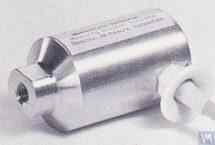
Figure 4.5. Model T77 sensor by Schenck It should be noted that due to the labor intensity of their production, inductive vibration velocity sensors are quite scarce and expensive items. Therefore, despite the obvious advantages of these sensors, amateur manufacturers of balancing machines use them very rarely.
4.1.2.2. Vibration Velocity Sensors Based on Piezoelectric Accelerometers. A sensor of this type differs from a standard piezoelectric accelerometer by having a built-in charge amplifier and integrator within its housing, which allows it to output a signal proportional to vibration velocity. For example, piezoelectric vibration velocity sensors manufactured by domestic producers (ZETLAB company and LLC “Vibropribor”) are shown in Figures 4.6 and 4.7.

Figure 4.6. Model AV02 sensor by ZETLAB (Russia)

Figure 4.7. Model DVST 2 sensor by LLC “Vibropribor” Such sensors are manufactured by various producers (both domestic and foreign) and are currently widely used, especially in portable vibration equipment. The cost of these sensors is quite high and can reach 20,000 to 30,000 rubles each, even from domestic manufacturers.
4.1.3. Displacement Sensors In the measurement systems of balancing machines, non-contact displacement sensors – capacitive or inductive – can also be used. These sensors can operate in static mode, allowing the registration of vibrational processes starting from 0 Hz. Their use can be particularly effective in the case of balancing low-speed rotors with rotation speeds of 120 rpm and below. The conversion coefficients of these sensors can reach 1000 mV/mm and higher, which provides high accuracy and resolution in measuring displacement, even without additional amplification. An obvious advantage of these sensors is their relatively low cost, which for some domestic manufacturers does not exceed 1000 rubles. When using these sensors in balancing machines, it is important to consider that the nominal working gap between the sensor’s sensitive element and the surface of the vibrating object is limited by the diameter of the sensor coil. For example, for the sensor shown in Figure 4.8, model ISAN E41A by “TEKO,” the specified working gap is typically 3.8 to 4 mm, which allows for the measurement of displacement of the vibrating object in the range of ±2.5 mm.
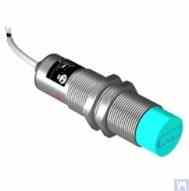
Figure 4.8. Inductive Displacement Sensor Model ISAN E41A by TEKO (Russia)
4.1.4. Force Sensors As previously noted, force sensors are used in the measurement systems installed on Hard Bearing balancing machines. These sensors, particularly due to their simplicity of manufacture and relatively low cost, are commonly piezoelectric force sensors. Examples of such sensors are shown in Figures 4.9 and 4.10.

Figure 4.9. Force Sensor SD 1 by Kinematika LLC

Figure 4.10: Force Sensor for Automotive Balancing Machines, Sold by “STO Market” Strain gauge force sensors, which are manufactured by a wide range of domestic and foreign producers, can also be used to measure relative deformations in the supports of Hard Bearing balancing machines.
4.2. Phase Angle Sensors For synchronizing the vibration measurement process with the rotation angle of the balanced rotor, phase angle sensors, such as laser (photoelectric) or inductive sensors, are used. These sensors are manufactured in various designs by both domestic and international producers. The price range for these sensors can vary significantly, from approximately 40 to 200 dollars. An example of such a device is the phase angle sensor manufactured by “Diamex,” shown in figure 4.11.
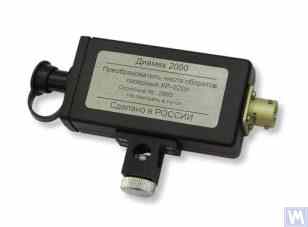
Figure 4.11: Phase Angle Sensor by “Diamex”
As another example, Figure 4.12 shows a model implemented by LLC “Kinematics”, which uses laser tachometers of the DT 2234C model made in China as phase angle sensors. The obvious advantages of this sensor include:
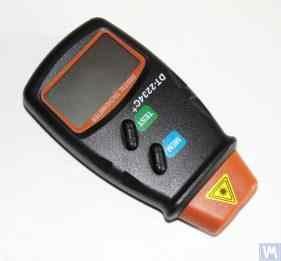
Figure 4.12: Laser Tachometer Model DT 2234C
ในบางกรณี เมื่อการใช้เซ็นเซอร์ออปติคอลเลเซอร์ไม่เป็นที่พึงปรารถนาไม่ว่าด้วยเหตุผลใดก็ตาม สามารถเปลี่ยนเซ็นเซอร์เหล่านี้ด้วยเซ็นเซอร์ดิสเพลสเมนต์เซนเซอร์แบบไม่สัมผัสแบบเหนี่ยวนำได้ เช่น รุ่น ISAN E41A ที่กล่าวถึงก่อนหน้านี้หรือผลิตภัณฑ์ที่คล้ายคลึงกันจากผู้ผลิตรายอื่น
4.3. คุณสมบัติการประมวลผลสัญญาณในเซ็นเซอร์สั่นสะเทือน สำหรับการวัดแอมพลิจูดและเฟสที่แม่นยำของส่วนประกอบการหมุนของสัญญาณการสั่นสะเทือนในอุปกรณ์ปรับสมดุล โดยทั่วไปแล้วจะใช้เครื่องมือประมวลผลฮาร์ดแวร์และซอฟต์แวร์ร่วมกัน เครื่องมือเหล่านี้ช่วยให้:
4.3.1. การกรองสัญญาณบรอดแบนด์ ขั้นตอนนี้จำเป็นสำหรับการทำความสะอาดสัญญาณเซ็นเซอร์สั่นสะเทือนของการรบกวนที่อาจเกิดขึ้นทั้งที่ขอบเขตล่างและบนของช่วงความถี่ของอุปกรณ์ ขอแนะนำให้ใช้อุปกรณ์ตรวจวัดของเครื่องชั่งเพื่อตั้งค่าขีดจำกัดล่างของตัวกรองแบนด์พาสเป็น 2-3 Hz และขีดจำกัดบนเป็น 50 (100) Hz การกรอง "ต่ำกว่า" ช่วยลดสัญญาณรบกวนความถี่ต่ำซึ่งอาจปรากฏที่เอาต์พุตของแอมพลิฟายเออร์การวัดเซนเซอร์ประเภทต่างๆ การกรอง "ด้านบน" ช่วยลดความเป็นไปได้ของการรบกวนเนื่องจากความถี่ผสมและการสั่นเรโซแนนซ์ที่อาจเกิดขึ้นของส่วนประกอบทางกลแต่ละส่วนของเครื่องจักร
4.3.2. การขยายสัญญาณอนาล็อกจากเซนเซอร์ หากจำเป็นต้องเพิ่มความไวของระบบตรวจวัดของเครื่องชั่ง ก็สามารถขยายสัญญาณจากเซ็นเซอร์สั่นสะเทือนไปยังอินพุตของหน่วยตรวจวัดได้ สามารถใช้ทั้งแอมพลิฟายเออร์มาตรฐานที่มีเกนคงที่และแอมพลิฟายเออร์หลายสเตจซึ่งสามารถเปลี่ยนแปลงโดยทางโปรแกรมโดยขึ้นอยู่กับระดับสัญญาณจริงจากเซ็นเซอร์ ตัวอย่างของแอมพลิฟายเออร์หลายสเตจที่ตั้งโปรแกรมได้ ได้แก่ แอมพลิฟายเออร์ที่ใช้ในตัวแปลงการวัดแรงดันไฟฟ้า เช่น E154 หรือ E14-140 โดย LLC "L-Card"
4.3.3. บูรณาการ ตามที่ระบุไว้ก่อนหน้านี้ แนะนำให้ใช้การรวมฮาร์ดแวร์และ/หรือการรวมสัญญาณเซ็นเซอร์การสั่นสะเทือนสองครั้งในระบบการวัดของเครื่องจักรปรับสมดุล ดังนั้น สัญญาณมาตรความเร่งเริ่มต้น ซึ่งเป็นสัดส่วนกับการเร่งความเร็วของไวโบร สามารถแปลงเป็นสัญญาณที่เป็นสัดส่วนกับความเร็วไวโบร (การบูรณาการ) หรือการเคลื่อนที่ของไวโบร (การอินทิเกรตสองครั้ง) ในทำนองเดียวกัน สัญญาณเซ็นเซอร์ความเร็วไวโบรหลังการรวมเข้าด้วยกันสามารถเปลี่ยนเป็นสัญญาณตามสัดส่วนกับการกระจัดของไวโบรได้
4.3.4. การกรองย่านความถี่แคบของสัญญาณอะนาล็อกโดยใช้ตัวกรองการติดตาม เพื่อลดการรบกวนและปรับปรุงคุณภาพของการประมวลผลสัญญาณการสั่นสะเทือนในระบบการวัดของเครื่องปรับสมดุล จึงสามารถใช้ตัวกรองการติดตามแถบความถี่แคบได้ ความถี่ส่วนกลางของตัวกรองเหล่านี้จะถูกปรับตามความถี่ในการหมุนของโรเตอร์ที่สมดุลโดยอัตโนมัติ โดยใช้สัญญาณเซ็นเซอร์การปฏิวัติของโรเตอร์ วงจรรวมสมัยใหม่ เช่น MAX263, MAX264, MAX267, MAX268 โดย “MAXIM” สามารถใช้เพื่อสร้างตัวกรองดังกล่าวได้
4.3.5. การแปลงสัญญาณอนาล็อกเป็นดิจิทัล การแปลงแอนะล็อกเป็นดิจิทัลเป็นขั้นตอนสำคัญที่ช่วยให้มั่นใจถึงความเป็นไปได้ในการปรับปรุงคุณภาพของการประมวลผลสัญญาณการสั่นสะเทือนในระหว่างการวัดแอมพลิจูดและเฟส ขั้นตอนนี้ใช้กับระบบการวัดที่ทันสมัยทั้งหมดของเครื่องปรับสมดุล ตัวอย่างการใช้งาน ADC ดังกล่าวอย่างมีประสิทธิผล ได้แก่ ตัวแปลงการวัดแรงดันไฟฟ้าประเภท E154 หรือ E14-140 โดย LLC “L-Card” ซึ่งใช้ในระบบการวัดหลายระบบของเครื่องจักรปรับสมดุลที่ผลิตโดย LLC “Kinematics” นอกจากนี้ LLC “Kinematics” ยังมีประสบการณ์ในการใช้ระบบไมโครโปรเซสเซอร์ราคาถูกที่ใช้คอนโทรลเลอร์ “Arduino”, ไมโครคอนโทรลเลอร์ PIC18F4620 จาก “Microchip” และอุปกรณ์ที่คล้ายกัน
Author of the article : Feldman Valery Davidovich
บรรณาธิการและการแปล : Nikolai Andreevich Shelkovenko
ฉันขอโทษสำหรับข้อผิดพลาดในการแปลที่อาจเกิดขึ้น
